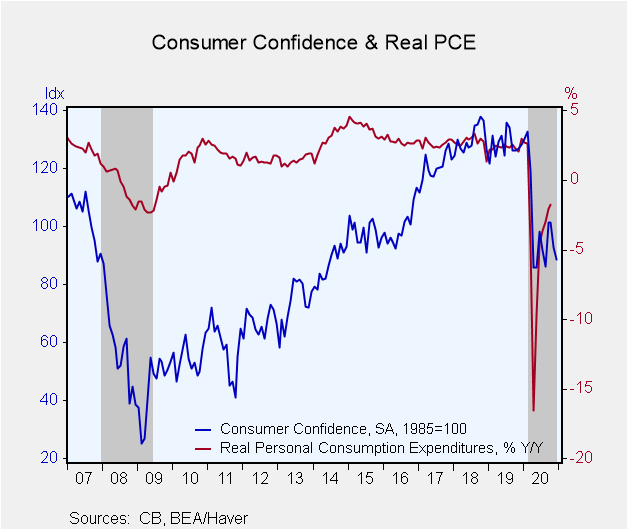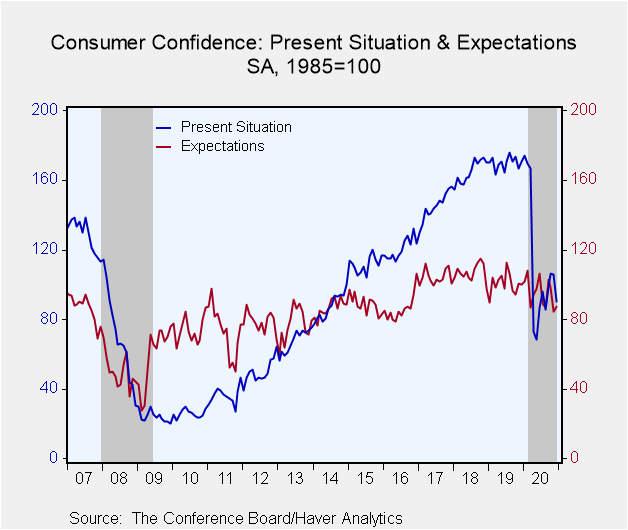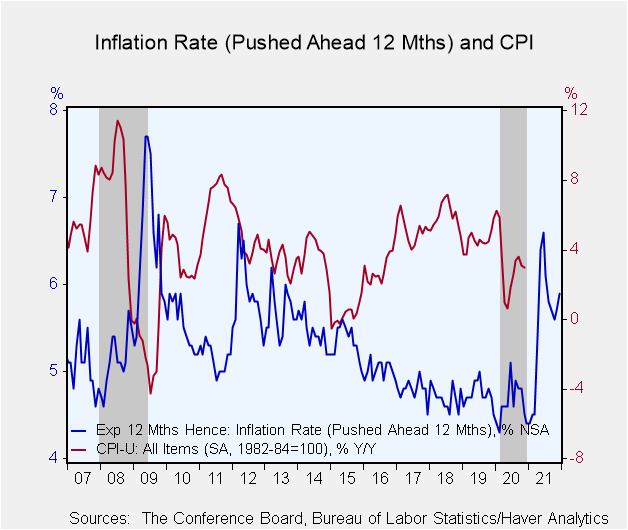 Global| Dec 22 2020
Global| Dec 22 2020U.S. Consumer Confidence Drops in December
Summary
• Conference Board measure of consumer confidence falls for second consecutive month; lowest since August. • Current conditions index plummets while expectations rise. • Jobs gap suggests flat-to-up unemployment rate in December. The [...]
• Conference Board measure of consumer confidence falls for second consecutive month; lowest since August.
• Current conditions index plummets while expectations rise.
• Jobs gap suggests flat-to-up unemployment rate in December.
The Conference Board Consumer Confidence Index fell a great-than-expected 4.6% to 88.6 in December (-30.9% year-on-year), from a downwardly revised 92.9 in November (was 96.1). This is the second consecutive decline, the lowest reading since August, and was well below the Action Economics Forecast Survey forecast of 97.5.
Consumer views of the current situation and expectations dropped in December, with the present situation down 14.7% to 90.3 (-47.0% y/y). Meanwhile, expectations increased 3.8% to 87.5 (-12.5% y/y). This is the reverse of November, when expectations fell and current conditions were relatively steady. The jobs gap, representing the difference between respondents indicating 'jobs are plentiful' and those saying 'jobs are hard to get', declined to -0.2% from +6.9% suggesting the unemployment rate will hold steady or potentially rise in December. This series has an 80% correlation with the unemployment rate over the last ten years (see chart in lower left hand corner). The decline in the labor market differential was the result of both a decrease in the 'jobs plentiful' measure and a rise in the 'jobs hard to get' index.
Interestingly, despite generally soft inflation readings – headline CPI inflation was just 1.2% y/y in November – the expected inflation rate in twelve months rose to 5.9% from 5.7%, the fastest since July. Perhaps this is the result of rising energy prices (for more see today's commentary on energy prices). The share of respondents planning on buying a new home in six-months slid to 5.2% in December the lowest since November 2019. Meanwhile, those planning on buying a major appliance rose to 47.7% from 32.0%.
Confidence fell for both those under 35 and over 55, while it rose for the 35-to-54 age group.
The Consumer Confidence data are available in Haver's CBDB database. The total indexes, which are indexed to 1985=100, appear in USECON, and the market expectations are in AS1REPNA.
| Conference Board (SA, 1985=100) | Dec | Nov | Oct | Dec '19 | 2019 | 2018 | 2017 |
|---|---|---|---|---|---|---|---|
| Consumer Confidence Index | 88.6 | 92.9 | 101.4 | 128.2 | 128.3 | 130.1 | 120.5 |
| Present Situation | 90.3 | 105.9 | 106.2 | 170.5 | 169.8 | 164.8 | 144.8 |
| Expectations | 87.5 | 84.3 | 98.2 | 100.0 | 100.6 | 107.0 | 104.3 |
| Jobs Gap (%) | -0.2 | 6.9 | 7.1 | 33.5 | 33.2 | 27.6 | 14.0 |
| Jobs Plentiful (%) | 21.8 | 26.3 | 26.7 | 46.5 | 45.8 | 42.0 | 32.4 |
| Jobs Hard to Get (%) | 22.0 | 19.4 | 19.6 | 13.0 | 12.6 | 14.4 | 18.4 |
Gerald D. Cohen
AuthorMore in Author Profile »Gerald Cohen provides strategic vision and leadership of the translational economic research and policy initiatives at the Kenan Institute of Private Enterprise.
He has worked in both the public and private sectors focusing on the intersection between financial markets and economic fundamentals. He was a Senior Economist at Haver Analytics from January 2019 to February 2021. During the Obama Administration Gerald was Deputy Assistant Secretary for Macroeconomic Analysis at the U.S. Department of Treasury where he helped formulate and evaluate the impact of policy proposals on the U.S. economy. Prior to Treasury, he co-managed a global macro fund at Ziff Brothers Investments.
Gerald holds a bachelor’s of science from the Massachusetts Institute of Technology and a Ph.D. in Economics from Harvard University and is a contributing author to 30-Second Money as well as a co-author of Political Cycles and the Macroeconomy.









